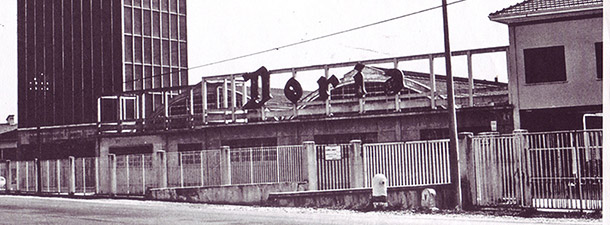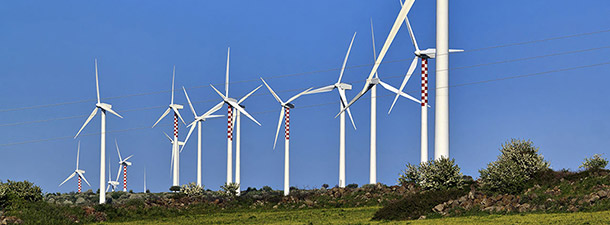
Is Corporate Social Responsibility Anti-State? A Programme
agosto 1, 2013
DORIA Amarcord
agosto 1, 2013For more than 10,000 years the climate and CO2 concentration of our planet have been very stable, but now we humans are pushing it to a dangerous level. It has gone beyond 400 parts per million as a measurement of the concentration of the CO2 in the air. The best evidence suggests that the CO2 levels on Earth have not been this high for three million years or more – since before humans evolved.
I am going to share my thoughts from a very subjective personal point of view. I might be biased, as I am involved in two of the technologies I am going to outline here, but overall I think it is time for a radical shift, a radical change. We have been talking for many, many years about the need for radical climate change action. There is a good consensus in the scientific literature that the instability of climate patterns is down to human activity. If you look back ever since the industrial revolution, we humans have been squeezing the oil, the gas, the coal wherever we can find it out of the crust of the Earth to fuel our economic growth. It is not surprising that the loading of the earth’s atmosphere with carbon dioxide and other greenhouse gas-related emissions has had an effect on the planet. The impact derives largely from our human intervention in the balance of the ecosystem.
We are really squeezing the Earth, and we are doing it in a very short time frame, in terms of the history of the planet. I saw a statistic the other day that we have had 10,000 years of very stable CO2 emission concentrations but now we are already beyond 400 parts per million. The target which has been touted as what is necessary to achieve stabilisation of the climate is 380 parts per million – we are already beyond this at dangerous levels. A lot of talk has happened, a lot of agreements have been made through the Kyoto Protocol, but there has been little impact – we are still lacking any substantial change. Alternative technological solutions, like solar and wind power, have only been successful in pockets of the global economy, particularly in countries that have been given massive subsidies, such as Germany, where the solar industry has emerged with over twenty gigawatts of installed capacity. Now these are exceptions not the norm, but statements like those coming from Saudi Arabia that they are planning to install forty gigawatts of solarconcentrated technology and solar photovoltaics (PVs) over the next five years is encouraging.
I think they have realised that burning their oil and gas is going to be much more expensive than putting solar farms on desert land, where there is plenty of space available. The only challenge they are facing currently there is heat and sand, as solar PV panels in particular have to be kept free of dust to deliver optimum outputs.
In addition to the increasing economic efficiency of solar, it is socially highly beneficial, in that solar creates a lot more jobs than other forms of power production.
On the other hand, the country where I am currently living, Malaysia, has currently set a 40 percent carbon intensity reduction target. However, the trends are different, as two massive coal-fired power plants are just in the process of being commissioned and there are still signs of a power-hungry population and industry driving up energy consumption, with limited efforts going into energy efficiency.
And government massively subsidises the cost of electricity – monies which encourage waste instead of the efficiency that would reduce overall energy consumption.
Energy efficiency as a priority policy for Malaysia would be ideal to support the developed nation status which the country aspires to achieve by 2020. Developed countries have usually very energy efficient economies, because you cannot afford to throw away too much money by running your economy in an inefficient way. So the game is on. We need to find opportunities to shift; we need to find opportunities to really make a difference; and we need to find technologies that can turn the tide of more, and more, and more CO2 emissions.
humans on the planet, we need to shift to more ecological efficiency. Let me give you two examples I am personally involved in that are rather difficult to implement on a large scale because – as I see it – there is a lack of commitment and of faith in investing in green technology, particularly at this point in time. This is mainly because some of these industries have been choppy from an investor’s point of view with regard to return of investment.
In addition some of them rely a great deal on government policies, and other industries are so locked up and closed by conventional power sources or technologies that it is very hard for new and emerging technologies to make their way in the marketplace.
The first company I want to look at is Solexel, an American solar cell manufacturing company based in Silicon Valley California.
What is amazing about this company is that they have added and licensed over 170 patents to create a low cost-to-manufacture but high efficiency cell with over 20 percent efficiency, with a roadmap to 24 percent. It was this company that was able to raise significant amount of investor capital last year – this is truly difficult in a challenged sector like solar cell manufacturing.
Several very high profile solar companies have declared bankruptcy including Solera in the US; Suntech, China’s biggest solar company; QCells from Germany, which was recently taken over by the Korean company Han Wah. So overall confidence in this sector is at rock bottom, similar to the dot.com bust in early 2000.
Or, alternatively, it is similar to when the semiconductor industry had a consolidation period in the late 60s and early 70s. Interestingly enough, the trend of solar cell sales looks very, very similar to the trend of semiconductors where you had massive growth, slight consolidation and massive rise again to much, much greater heights.
I personally think we will see the same with solar technology. The fact that solar prices came down precipitously some years ago from $1.50 to $0.70 or $0.80 per watt is a hugely significant change that makes solar energy competitive as compared with conventional fossil fuel-based industries. And with solar, you do not have fuel price fluctuations as you do with coal or gas – the sun keeps hitting the panels free of charge.
Here in Malaysia there are discussions about planning and then switching on a nuclear power plant in 2020. I am very convinced that solar will be very much cheaper by then in Malaysia and will generate many more local jobs. The price of nuclear power is going up as people realise they need much greater security measures after Fukushima. Some extra measures are being installed that cost loads of additional money. Furthermore, the cost for nuclear waste handling and decommissioning of old plants is going up considerably. In Germany, for example, the government has allocated another 10 billion euros for managing the nuclear waste mine. The trends are clear, solar is coming down in cost and nuclear is going up.
Long term, Solexel’s plans are to generate 1 kilowatt hour at 6 cents per kilowatt hour. What is unique about Solexel is that the light weight and bendable technology means it does not need massive glass and aluminium frames.
That reduces the overall balance of system’s cost, but the problem is that at this stage and time (as I have had some investor discussion as well), it is extremely hard to find people to put money behind it, because overall investors are very, very cautious. A contrarian point of view is that this would be the best time to invest as valuation is low and opportunity upside is potentially huge; plus, the market is going through consolidation – fewer companies are actually going to be manufacturing in the near future and size of output is consolidating. So there is a lot of opportunity out there for growth.
Solar is definitely an industry that is making a big impact, but it needs to make an even bigger impact. Hopefully, innovative technologies such as Solexel will actually be finding more support in the marketplace and then grow quickly to achieve a much more lower cost in power generation than non-renewable sources.
The other company I work with, called Maleki GmbH, in Germany has what I think is the best technology to make concrete with high performance and minimal environmental impact. This provides huge opportunities considering that cement in the concrete makes up 6 percent or more of global CO2 emissions. This can be massively reduced. But people are used to using what they have always done before. If you want to compete in that sector, you need capital, connection and a great deal of market education.
The time has come for people with money and resources to step up to push such opportunities for game change. My experience is that such technologies are having a challenging time, as the economy likes to put money into money-making systems that are “proven” and simple to understand, copying what has been done many times before.
But the future of your children is at stake. Making changes now will be much cheaper than when Mother Nature unleashes even more changes as a response to our neglect.
It is time for people with resources to look at technologies with gamechanging potential and then to step up and support such technologies. We have waited too long already. Nature does not wait. It responds.




